


A program in observational astronomy to search the Virgo Cluster of Galaxies for supernovae (SNe) using inexpensive consumer digital camera "backyard astronomy" equipment, and covering some 175 galaxies over ~100 square degrees of sky with 3 pixel positional accuracy, which is ~20 arc-seconds, or ~1/60th of a millimeter on the sensor inside the camera.
Motivation | Explanation | Remedy | VISNS v.1 | Results | v.2 | References | Sky Chart | Donate!
[ This Month in the History of Astronomy - Now 560+ entries & 50+ kilowords ]
[ About the time my work made the cover of Science magazine ]
[ Results from the 2017 Great American Solar Eclipse ]
[ The most technically difficult and complex example
of dynamic landscape photography ever! ]
[ From the Archives: Astronomical Imagery in Navajo Weaving (1990) ]
[ Comet Giacobini-Zinner passes in front of M35 ]
[ My Comet PANStarrs photo made Sky & Telescope's Gallery ]
[ 2017 Ursid Meteor
Shower: An Interesting Observation || A Bright α-Capricornid Meteor ||
A Possible New Shower?
("SW3") ]
[ From the Archives #2: Adaptive Center Weighted Median (ACWM)
Digital Picture Filtering (1996) ]
[ The 11/11/2019 Mercury Transit ]
[The Great Conjunction (Jupiter/Saturn: Dec 21, 2020) ]
[ The Apr 30, 2022, Jupiter/Venus Conjunction ]
[ How Good Was Kodachrome? A Colorimetric Analysis of its Spectral Sensitivities ]
[ BitCoin Epistemology for Dummies (2017) ]

An investigation conducted in early 2015 of the relevant literature showed that only one-third (14 of 43)* of the SNe ever discovered in our nearest neighboring large cluster of galaxies, the Virgo Cluster, had been found since 1990 -- even though the rate of SNe discovery overall has since increased by something like a factor of 20-30x:
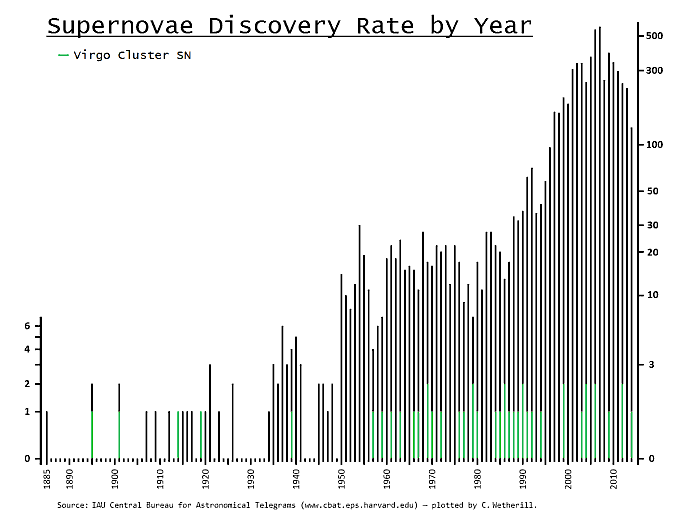
Note the logarithmic vertical scaling, which compresses the size of the
increase that started in the
late-1980s. The increase from 1935 well into
the post-WWII era is due to Zwicky's
pioneering work.
The graph raises the obvious question: were all of the Virgo Cluster's SNe being discovered several decades ago, and if not are they all being found today? Is the rate really 1 ±1 per year? VISNS is designed to give a better value for this number.
* - The numbers here strictly apply only to the sample of the ~125 brightest galaxies in the cluster on my observing list in the region around M87/Vir A, which is usually taken to be the center of the main core of the cluster. See sky map and footnote below.
BTW - The apparent downturn in the number of SNe discovered per year after about 2005 which is easily visible in the graph is a reporting artifact. Simply put, there were so many groups finding so many SNe by then that they stopped reporting them individually to the IAU. As of a decade later or so, the reputed number was on the order of about ten per day, or 3,500-4,000 per year SNe being discovered.
The advent 25-30 years ago of computer controlled telescopes and specialized astronomical digital cameras has caused the number of SNe discovered annually around the world and across the sky to increase from some fifteen or two dozen in the four decades following WWII to many hundreds per year by the 2000's. This classic example of 'technoscience' in action (Sullivan, 2009) has led to a Nobel Prize and a re-modelling of the model of the universe, which now emphasizes 'dark energy' as dominating even 'dark matter' as the principle constituent of the cosmos.
One would naturally expect the number of supernovae discovered in the Virgo Cluster to have scaled up similarly, but in fact it hasn't. The number has stayed at zero to two per year throughout this time, and, for example, while there were 573 SNe found in 2007 none at all were in the Virgo Cluster.
This may actually be easy to understand: even a small (~½-meter) observatory class telescope can image to levels perhaps ~100x fainter than is needed to find SNe in the nearby (astronomically speaking) cluster. This corresponds to a distance ~10x greater, or 500+ million light years (Mly) rather than ~50-60 Mly. There is obviously a correspondingly much greater volume of space to survey at the fainter levels and greater distances, so many more galaxies (and SNe) can be found there. See this demonstration of exactly what I'm talking about.
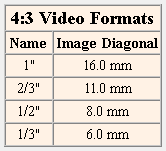 There are other possible considerations: some of the
Virgo galaxies may be so close as to be too big for a modest camera system.
Cassegrain telescopes (which are perhaps most common) have long focal
lengths and big image scales: a 16" f/16 or 20" f/12 has F > 6000mm.
So even with a moderately large CCD sensor (~25mm diagonal) its field
of view will only be ~10-12 arc-minutes across. This is comparable to
the size of M100 and other large galaxies in the cluster. The photo at
left is from the National Geographic / Mount Palomar Sky Survey plate
scans, made with F=3450mm; the field is ~8'x12'. M100 turns out to be
the Virgo Cluster record holder with 5 SNe over the last 100+ years
(M99 has had four SNe.),
so the brighter galaxies in the cluster do get observational attention,
but only about one in ten from my fields has ever had a SNe discovered
in it.
There are other possible considerations: some of the
Virgo galaxies may be so close as to be too big for a modest camera system.
Cassegrain telescopes (which are perhaps most common) have long focal
lengths and big image scales: a 16" f/16 or 20" f/12 has F > 6000mm.
So even with a moderately large CCD sensor (~25mm diagonal) its field
of view will only be ~10-12 arc-minutes across. This is comparable to
the size of M100 and other large galaxies in the cluster. The photo at
left is from the National Geographic / Mount Palomar Sky Survey plate
scans, made with F=3450mm; the field is ~8'x12'. M100 turns out to be
the Virgo Cluster record holder with 5 SNe over the last 100+ years
(M99 has had four SNe.),
so the brighter galaxies in the cluster do get observational attention,
but only about one in ten from my fields has ever had a SNe discovered
in it. 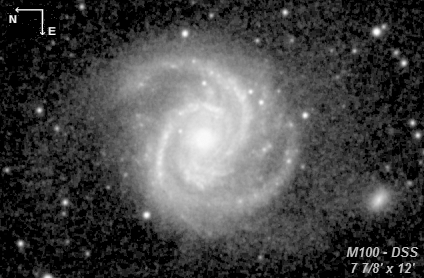 With a wide field, one can image many galaxies at once,
whereas a longer focal length and larger scale means they have to be done
one at a time, which is ultimately more expensive in terms of observation
time.
With a wide field, one can image many galaxies at once,
whereas a longer focal length and larger scale means they have to be done
one at a time, which is ultimately more expensive in terms of observation
time.
Whatever the exact reason, the rate of SNe discovery in the Virgo Cluster has not kept up with recent trends and advances in technology and capabilities. Solid state sensors are intrinsically 30x or more efficient than the silver based emulsions of the past, so apertures 5-6x smaller (Sqrt[30]) can do approximately as well. The 70mm diameter objective of a telephoto lens, with a digital camera, can perform about equivalently to a 14"-16½" telescope of several decades back shooting (slow) glass plates.
All this leaves an excellent sample of galaxies that are otherwise close enough for fairly detailed investigation but presumably also are not being very thoroughly searched for SNe, though doing so is not an extravagant undertaking.
VISNS is intended to fill this gap and remedy the evident neglect of the Virgo Cluster by current searches.
Much more modest equipment is sufficient for the task of finding SNe in the Virgo Cluster, which turns out to be within the capabilities of inexpensive consumer digital cameras with telephoto lenses.
If a conservative (pessimistic or long) distance to the Virgo Cluster is taken to be m-M=31½ (65 million light years; wikipedia lists m-M=31.1 or 54 Mly), and if SNe range in maximum absolute (intrinsic) brightness from M = -16½ up to M = -19, then their observed apparent magnitudes will peak at m=12½ down to m=15. This is roughly in line with the historical record: only three SNe in the cluster have ever been discovered brighter than m=12½ and but two brighter than m=12.
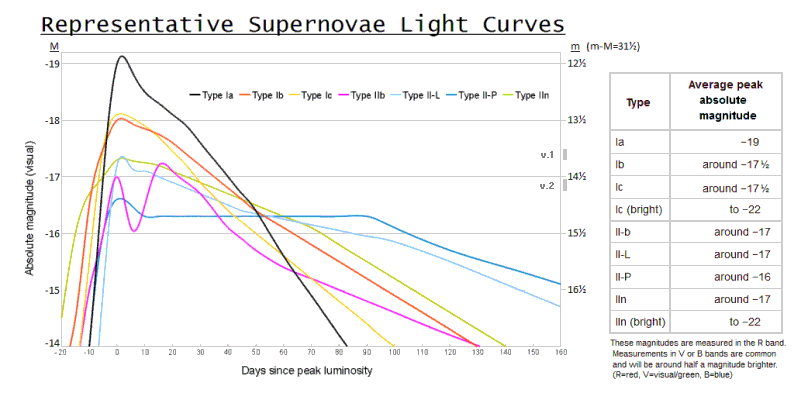
Experiments with an APS-C sized sensor DSLR -- a circa 2006-7 'pro-sumer' model camera (a Canon EOS 30D, otherwise a backup body I wasn't using) with an F=135mm f/2 telephoto lens (which I didn't use much and was thinking of unloading) -- were able to record, in a single 30 second exposure and without any special treatment, about a dozen cluster galaxies with m=13½ or more (fainter), like NGC 4516 (m=13.6):
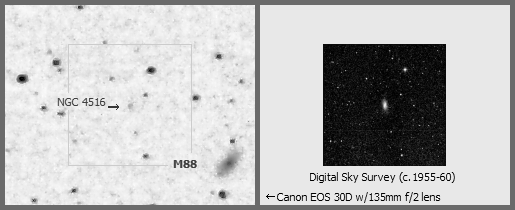
The DSS section is 20 arc-minutes square and scaled equivalently
to the v.1 image.
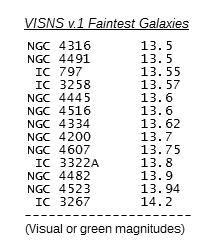
The Large Magellanic Cloud would have m≅13 at my assumed
distance.
Since galaxies are fuzzy they are almost always more difficult to detect than stars of comparable brightness, the latter's light being more concentrated. So these numbers suggest modest equipment like this -- using a photo tripod and a portable equatorial drive -- has a limiting magnitude in the m = 14 to 14¼ range. This is in good accord with expectations based on sensitivity estimations (how these are made), and it is enough to ensure that none of the brighter (Type I) SNe go undetected.
[In the Fall of 2016, the equipment was tested on Pluto, then listed as
being fortuitously right at m=14.2, but was unsuccessful at detecting it.
Pluto was 30+° lower in the sky compared to the Virgo Cluster, and this
extra atmospheric path length would have cost ~0.2 mags in 'extinction',
putting it just below the limiting single frame detection level.
At the end of August, 2019, I was finally able to get Pluto with the VISNS
v.2 set-up -- a 200mm telephoto lens and an APS-H DSLR -- on at least eight
nights, taking advantage of a run of exceptionally dry and transparent
weather conditions. Compare
Larry McNish's photo of Pluto with
mine taken the next night. Or turn up your monitor's brightness and watch
the movie made from two of my frames.]
Anyway, right now I'm not using frame stacking, though as you'll see below the capability is there since I'm taking more than one frame of each field.

Another one takes direct aim at the Pleiades... Don't make the same silly, careless mistake as
Princess Leia -- don't risk flying over my house in the middle of the night. Mwaaaahahaaa!!
Watch Comet Giacobini-Zinner cross in front of M35.
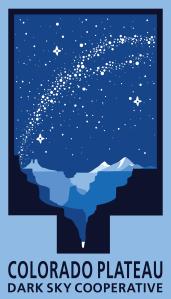
After setting up the equipment it's about as easy in practice to take several exposures as it is to take only one, so I settled on eight per field. In theory this can give as much as two more magnitudes of sensitivity. The other way to look at it is in terms of signal-to-noise ratio (S/N), which improves as the square root of the integration time (or almost 3x for eight): as net exposure time increases either a 'noise bump' (marginal detection) turns into an actual object or it melts back into the background noise.
The VISNS v.1 field of view (6 1/3° x 9½°) required three fields to cover the central core of the cluster, with a 50% vertical overlap. After setting up the equipment it's about as easy to do a few fields as it is to do just one. The main, middle field (centered on M87) was then entirely covered twice, which guarantees each galaxy is imaged on two different places on the sensor, and not too close to the edge of a frame in one or the other of the fields.
With VISNS v.1 all the galaxies on Sky & Telescope's Pocket Sky Atlas Close-up Chart C of the Virgo Cluster (Sinnott, 2006; see below) were located in single 30-second exposure. These total 64 galaxies: 47 in the M87 field, plus 8 more in the N offset (M100) field and 9 more in the S offset (M49) field.
The Revised Shapley-Ames Catalog of Bright Galaxies (RSACBG) then supplied another 36 galaxies in the fields: 27 in the main catalog and 9 more in its Appendix A (Additional Bright Galaxies).

With these 100 galaxies and their known positions it was then possible to calculate the 'plate constants' (-the term goes back to the silver emulsion on glass plates era), which are the numbers (coefficients) for the equations that transform from pixel (x,y) locations in the frames into celestial coordinates on the sky (longitude/latitude, or Right Ascension and Declination, RA/Dec). As an aside, this is one of the few instances where galaxies have been used as coordinate references this way; usually they are considered too fuzzy and their centers too poorly defined, compared to the simplicity of stars, for such purposes. But at a scale of ~10 arc-seconds per pixel it works, as we'll see. The pixel (x,y) values for each galaxy come from manually placing computer crosshairs over each one in one of the frames, centering it by "optical conjecture".
A computer program then finds the plate constants using standard linear least squares (sometimes called linear regression). The program also has to solve for the amount of rotation needed to square the pixel grid with the graph paper on the sky that the astronomical coordinate system represents. Recall, this is just a camera temporarily set up on a tripod and it's only possible to get things so level without going to too much trouble needlessly, since the program can find and remove whatever rotation there was.
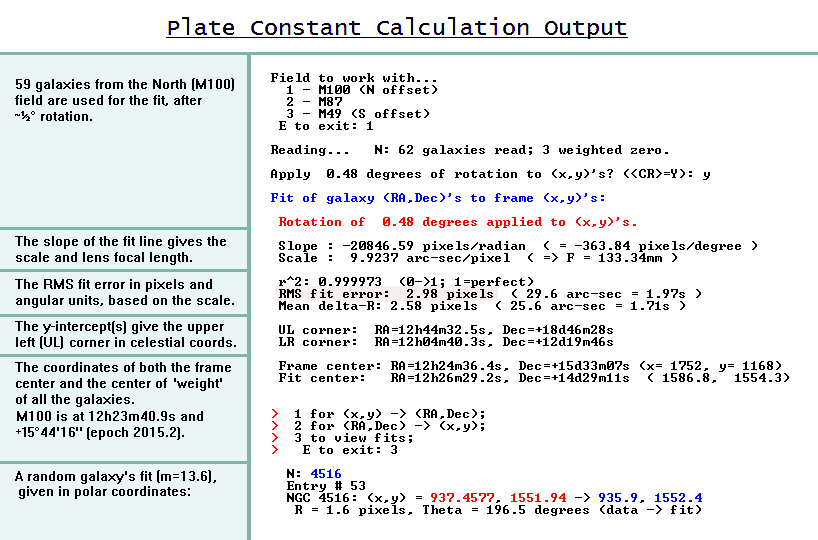
Technical details on the software: How It Works.
Here's a Finder Chart
for this North / M100 field, with
symbol darkness showing each galaxy's brightness.
With the plate constants in hand one can transform any (x,y) location in the frames into its astronomical coordinates (RA/Dec). By simple scrutiny of the images for the three fields, an additional three dozen objects that looked possibly non-stellar were ID'd as galaxies this way, by checking against catalogs like NASA's Extragalactic Database (NED). Even after four observing seasons (July 2018) I'm still occasionally making new finds of faint galaxies, like IC 3091 (V ~ 14.6), likely a background object (based on its recession velocity).
The inverse transformation takes astronomical coordinates (RA/Dec) and converts them into pixel (x,y) locations. Many of the fainter galaxies from the RSACBG were in fact first ID'd this way, as below about magnitude 12 2/3 to 13 the galaxies are dwarfs and can be less easy to distinguish casually from the many foreground stars (in the Milky Way) at that level. This is especially true for the S0 and E galaxies, which are intrinsically more condensed and thus can look star-like at this scale.
The inverse transformation also can be used to calculate each of the ID'd galaxy's expected locations in the frames, based on their cataloged celestial coordinates. When this is done for all the galaxies and compared against their actual, measured locations, the RMS fit error results (RMS = square Root of the Mean Square difference) -- a standard measure of the overall accuracy of the plate constants and the fit. This number is typically right at ~3.0 pixels after excluding the few galaxies that are off by ten or more pixels, which are almost always in the frame corners or near a far edge, where lens distortion starts to become apparent.
 ~3.0 pixels is an extraordinarily good result. For one
thing, a Bayer array sensor like this, where there is a red, green, or blue
filter over every pixel (as shown at right), so that the camera's onboard
computer chip has to synthesize the other two-thirds of the picture's RGB
data (of three color values per pixel) during readout via some sort of
interpolation scheme, is only theoretically capable of ~1½ pixel
resolution at best.
~3.0 pixels is an extraordinarily good result. For one
thing, a Bayer array sensor like this, where there is a red, green, or blue
filter over every pixel (as shown at right), so that the camera's onboard
computer chip has to synthesize the other two-thirds of the picture's RGB
data (of three color values per pixel) during readout via some sort of
interpolation scheme, is only theoretically capable of ~1½ pixel
resolution at best.
For another thing, the smallest star images in the best focused frames are some 3-4 pixels in diameter, about as expected for a mass produced lens. Also, recall I'm only estimating the galaxy locations in the frames to ±½ pixel, and as well the precision of the cataloged positions have a comparable uncertainty: the RSACBG gives an RA to the nearest whole second (of time), which is ±½ second, or ±7.5 arc-seconds -- which is ~3/4ths of a pixel.
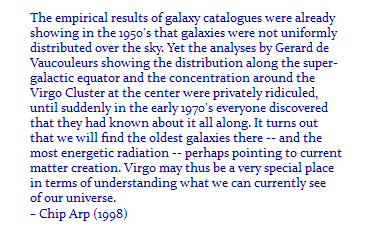
Each little uncertainty contributes to the total, so a net RMS fit error of ~3.0 pixels is about as good as could be anticipated, especially using such a mathematically simple, linear fit.
[One implication is that the lens used has a very good image over most of
the sensor area, out to 80-85% of the distance from the optical axis to the
frame corners, which includes 90+% of the area. (For a 3:2 aspect ratio, by
comparison, a 'long' or far edge is 83.2% of the distance to a corner.)
Other ways of saying this: the lens has a 'flat', distortion-free, or very
rectilinear image; equivalently, its magnification (scale) doesn't change
over the bulk of the image, to within the lens's ability to image point
sources (stars).
Also note that the lens's focal length falls out of the calculations. One of
the reasons for doing this was curiosity about how accurate the FL's stamped
on lenses are. Ansel Adams stated without any apparent reason that they were
good to ~1%, but both my lenses are off by more than that: the F=135mm lens
by 1.2% and the F=200mm lens by 2.8%; and both are on the short side. With
a 3 pixel RMS and a frame dimension of 3½-4K , these focal lengths are
accurate to better than a part in a thousand, or ~0.10-0.15 mm.]
All this was shaken out of VISNS v1.0 (2015) and v1.1 (2016).
The former consisted of 19 nights of observations from about the first week of February to the 3rd week of April (when the weather went bad for the next 6-8 weeks); between weather and bright moonlight this was about two nights per week.
The prime observing season for the cluster, when it is highest up (on the meridian) sometime during astronomical night, runs from the first week in January until a little past the middle of May. This is ~19 weeks. The overall observing season can run a few weeks more on each end, so for v1.1 I was able to go from 12/19/2015 to 6/25/2016: I got in 32 nights of observations over the 27 weeks, or a little more than one per week (5.9 days).
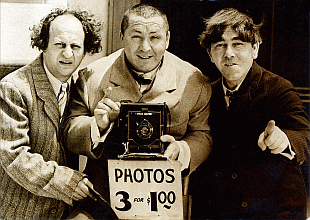 A typical observing run settled in as forty-four 30-second
exposures, after a short (1/20th second) exposure on Denebola, to check focus;
I usually stop the lens down a 'click' or two from wide open for better image
quality (depth of focus):
A typical observing run settled in as forty-four 30-second
exposures, after a short (1/20th second) exposure on Denebola, to check focus;
I usually stop the lens down a 'click' or two from wide open for better image
quality (depth of focus):
When everything is operating smoothly and there are no snags it takes an average of about 40 seconds per exposure, or ~40-45 minutes total, including setup and tear-down time. The original goal was to keep it to an easily withstandable hour or less, given frigid mid-winter nights at 4 AM.
Getting a handle on fundamental infrastructure such as the plate constants was a cloudy night goal of VISNS v.1, and with 50+ nights of imaging 100 galaxies, or 5000+ galaxy observations in all, it was then time to proceed to the project's primary goal of finding supernovae.
How many SNe should be expected?

With VISNS v.1 working out so well, VISNS v.2 is seeking funding primarily for 1) dedicated equipment, including a reasonable upgrade; and 2) general continuing support of the project -- about half for each of these.
With regard to #1, the observing gear consists of five parts; from the
ground up they are:
a) sturdy (4x5) tripod with custom machined center post for 3/8" bolt
b) Ioptron Sky Tracker equatorial drive
c) Manfrotto geared tripod head (for ~0.1° offset/pointing accuracy)
d) the camera body
e) the camera's lens
[ Polar aligning a iOptron Sky Tracker without a phone app ]
[I have seen at least two instances, one on the web and one in a magazine ad, where components b) and c) were switched, so the geared tripod head is used to polar align the drive, while the camera is attached to the drive through some other means, like a ball head.]
Using my own equipment I've noticed that during the Virgo observing season half of the year I tend to want to leave everything assembled and ready to take outside at the next good opportunity. Even though it all breaks down easily for other uses, the threshold for doing so gets raised, inhibiting some of my other uses for the gear.
In particular, getting good/best focus, starting from scratch, can be an annoying, slightly tedious hassle. At one point I experimented with making and using Bahtinov focusing masks (see photo at right).
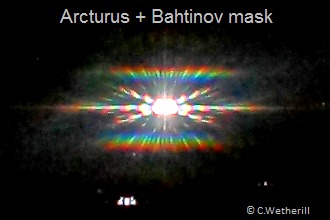
So once I get decent focus I like to tape it in place and not even touch the lens or the camera until forced to, which can be several weeks. The location of the exact focal plane for modern, fast telephoto lenses is temperature dependent, especially when they are shot nearly wide open; one no longer simply racks the lens focus in one direction to a physical stop at infinity (instead, the lens can focus "beyond infinity" a small amount), auto-focus doesn't work because there's nothing in a dark night sky to focus on, and as well the viewfinder may not be precisely the same distance from the lens as the sensor so visual focusing can be off slightly. (Pro level cameras have an auto-focus micro-adjustment feature, which can be calibrated through tests for each lens used on the camera and then dialed in once somewhere in the menu setting, since the body recognizes which lens is mounted on it.)
All these little difficulties would be obviated by having equipment dedicated soley to the project.
The overall success of VISNS v.1 also justifies upgrading the camera to an APS-H sensor size (now defunct), which is 25% larger in each dimension, or +56% in area. The bigger field of view with a given lens it provides versus an APS-C sensor is not needed, so instead a longer focal length lens is called for, F=200mm (f/2.8) rather than 135mm (f/2). This will cover approximately the same area on the sky while giving a larger image scale: ~6 arc-seconds per pixel rather than ~10.
Initial tests show a noticeable improvement in both image quality and sensitivity. Even though the two lenses have about the same light gathering power -- the slightly larger aperture diameter of the 200mm gives 0.10 more magnitudes -- the larger sensor and its better noise characteristics and onboard computer chip yields objects at least half a magnitude fainter.
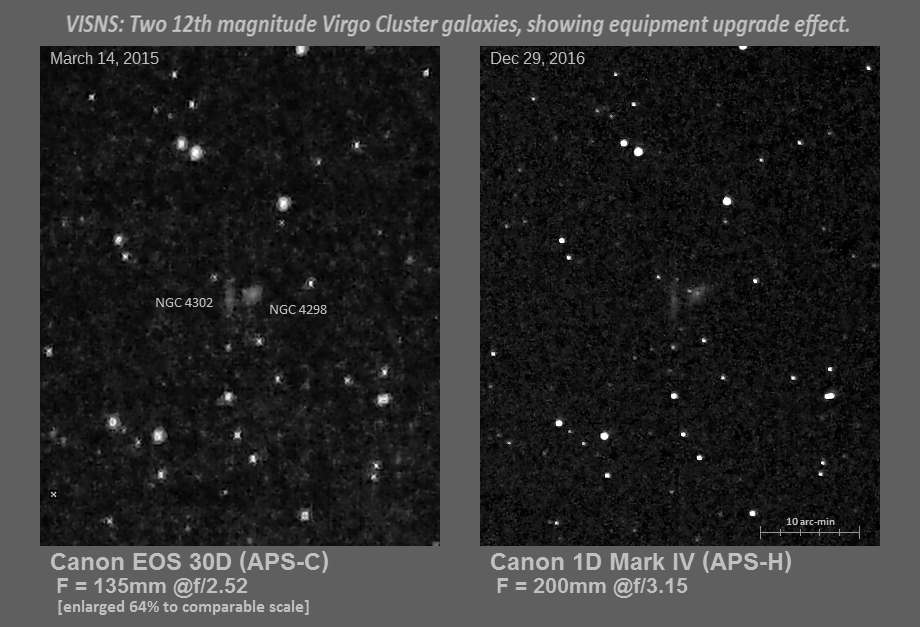
There's something interesting
about these photos if you look closely.
The faintest galaxies found with VISNS v.1 were at m=13.7 to 13.9, with one (IC 3267) listed at v=14.2, whereas VISNS v.2 shows several IC (Index Catalog) galaxies in the 14.5 to 14.7 range. This is just enough of an improvement to be able to turn up, in principle at least, even the fainter classes of SNe at the distance of the Virgo Cluster in a single 30-second exposure and without any frame stacking, so this upgrade seems easily justifiable.
The 2017 season was poor weather-wise, especially duing the new moons of
the prime observing period (Jan-Feb), when the fields are on the meridian
in the darkest hours before dawn, when I only got in 6 nights total (incl.
late-Dec 2016). By the end of the observing season in June the total was up
to about eighteen, so it ended better.
2018 was better, with something like two dozen decent nights logged. This
is about four per month during the Dec-Jun interval. Ideally these would be
plus and minus 5 or 6 days on either side of the new moon (2), on the new
moon (1), and then at least one other during the other ~18 days of the
month (1), with maybe one when the moon is bright but not too bright (plus
or minus 5 or 6 days on either side of the full moon) just because. Of
course the weather never fully cooperates with such well laid plans.
The 2019 observing season saw 29 nights with data collected, but only 9
during the prime time of Dec through Feb, when the fields are up highest
during the dark (and cold) wee hours of the AM, due to lousy winter
weather.
 With regard to #2, I'd feel like this project was
getting good crowd source support if ~$100 per night of observing came
in, which is ~$20-30 per day (~$1 per hour); hopefully there'll be a
lot of $2 and $5 donations.
With regard to #2, I'd feel like this project was
getting good crowd source support if ~$100 per night of observing came
in, which is ~$20-30 per day (~$1 per hour); hopefully there'll be a
lot of $2 and $5 donations.
As a reward program for keeping VISNS going...
For a $10 donation I'll sent you one of the data frames along with its dark frame (and a few other support files, like the galaxy ID list) if you'd like to play around with the data yourself. You'll need software that can read Canon .CR2 format files.
For $25 I'll sent you one complete set of eight light frames from one of the fields along with its dark frames, which is about a quarter of a night's take.
And for $100 I'll give you a copy of an entire night's worth of data which I haven't had a chance to thoroughly search yet.
Please donate via BitCoin, plastic card, or PayPal
(look for green"Send Tip" button). Yes, your $$$'s really can send me
out in the cold in the middle of the night.
Your money is no good on other planets (or galaxies) so you may as
well spend it now.
Buy Some Astronomy Today!
Thanks!!
So you think you own BitCoin? How do you know?
[ Back to Top ]
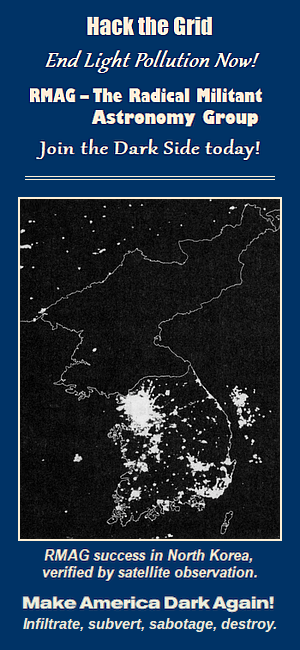
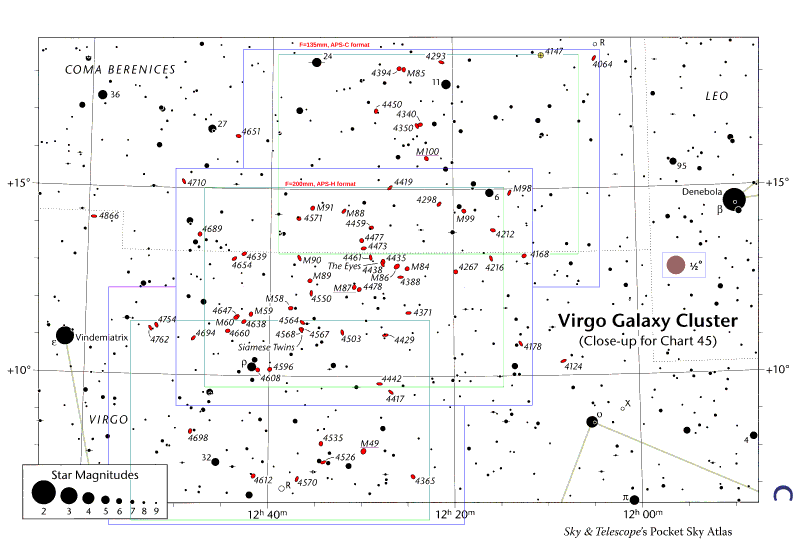
The blue lines show the VISNS v.1 frame boundaries, the green lines v.2.
The central v.1 frame shows 47 galaxies here.
The ~100 square degrees covered turns out to be about the same amount of
sky as is being surveyed by the Kepler satellite.
Source: Sky & Telescope's Pocket Sky Atlas (Sinnott, 2006).
M87 is 10+° E and 2° S of the star Denebola, which marks the tail of Leo, in an otherwise empty (to the eye) part of sky. Third magnitude ε Virginis (Vindemiatrix) is ~8° further in the same direction.
The overall cluster core is about 40 minutes wide in RA (right ascension), or ~10°, and is elongated somewhat, slanting diagonally at an ~25° angle from the SSE up to the NNW. My various statistics apply only to the galaxies I've been able to find in my single 30-second exposure frames of the three fields. That is, I haven't used some master list of cluster members, which may contain galaxies or areas on the sky that I'm not observing.
Perhaps the most notable exception is the starburst galaxy M61 (N4303), which has had at least 7 SNe discovered in it, and at least 4 in just the 1999-2015 period. It is just a little S of my South/M49 field.
A few of my galaxies are clearly background objects, with recession velocities ~7500 km/s. With Hubble's Law and Ho=75, these are at a distance of ~100 Mpc, or ~5x farther than the Virgo Cluster. This corresponds to m-M=35, so a typical bright galaxy like the Milky Way or M31 (or M100/NGC 4321) with M≈-21 will be visible at m≅14 (or so) out to distances like this with my equipment. A 30 kpc diameter galaxy at this distance will subtend ~10 pixels at my scale, which will make it distinguishable from a star (3-4 pixels). Examples would be IC 792 (type Sb/ScII, v = 6222 km/s), UGC 7230 (type SBd pec, v = 7145 km/s), VCC 435 (type Sa, v = 7778 km/s), or the NGC 4166 group (v ~ 7050 km/s).
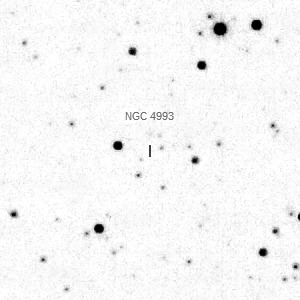
Galaxies of roughly similar brightness to those in the Virgo Cluster (or brighter) stretch along this general SSE - NNW slanting direction for some 50° more all the way up to the cup of the Big Dipper -- and, in the other direction, almost the same distance down to Centaurus. The newly famous S0 galaxy NGC 4993 (mag 13 1/3, through 2.2 air masses and with less than excellent skies @right), the site of the recent binary neutron star merger/collision producing gravity waves, as well as the accompanying 'kilonova' observed in electromagnetic waves across the spectrum from gamma rays to radio wavelengths, is part of this stream of galaxies across the sky, a little E of the bottom of Corvus, at about twice the physical distance of the Virgo Cluster. My highest numbered NGC galaxy is N4762, so N4993 is not very much further E because of the way the catalog is ordered, but it's some 30° S of the bottom of my South/M49 field. This region of sky is so little explored that the sky survey photo of the area shows quite a few uncatalogued galaxies.
The research of the last several decades has shown that the Milky Way, and the Local Group of Galaxies of which it's a part, is on the outskirts of this Virgo Supercluster of Galaxies, and due to gravity is falling towards it -- but not enough that the expansion of the universe isn't still increasing the distance between us and the cluster to the tune of ~1000 km/sec, or ~2¼ million miles per hour!
The region of sky around the Virgo Cluster is generally devoid of stars brighter than the fifth or sixth magnitude because we're looking up out of the thin plane of the Milky Way. The North Galactic Pole (NGP) is only ~15° away to the N-NNE. So those in the Virgo Cluster would see the Milky Way nearly face on, much as we see M100, which is sometimes said to be one of the galaxies the Milky Way probably most resembles. And, in case you're wondering, the Milky Way's sense of rotation as seen from the Virgo Cluster (or NGP) is clockwise.
About 6° W of the NGP (right, if you're facing S) is the visually faint Coma Berenices star cluster, which is both easy to find in a decently dark sky and is a good test of sky darkness and transparency. At my site I measure 20½ magnitudes per square arc-second or a little better (20¾ max) on clear, moonless nights. The Coma Berenices star cluster is almost exactly twice as far away in distance as the much more famous Hyades cluster.
BTW - the close approaching Asteroid 2014 JO25 came right through this region of the sky on the night of April 19-20, 2017, passing right by the NGP and the galaxy M64 -- all just to the E of the Coma Berenices cluster -- on its NNE to SSW path along the E edge of my fields.
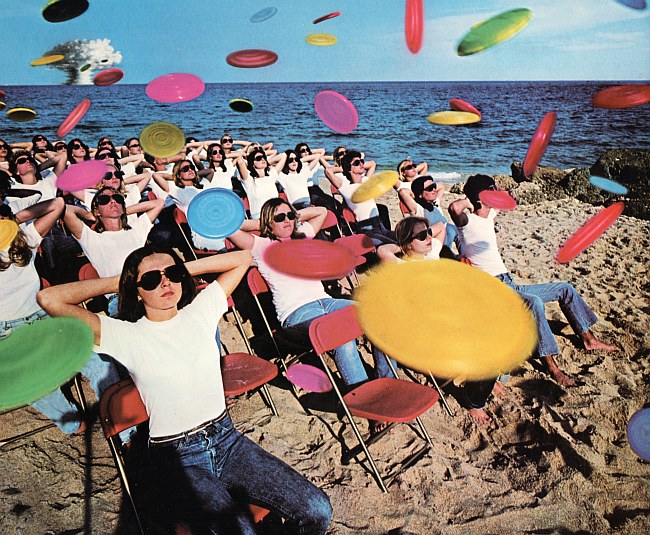
Flash and the Pan's observations of the people at the Great Frisbee
Eclipse of 1979.
Backstory (using Arecibo to search the Virgo Cluster for neutral hydrogen clouds)

Tilt your vision to the right if you don't see this incredible
Easter Island-like head looking up at the sky in this boulder:
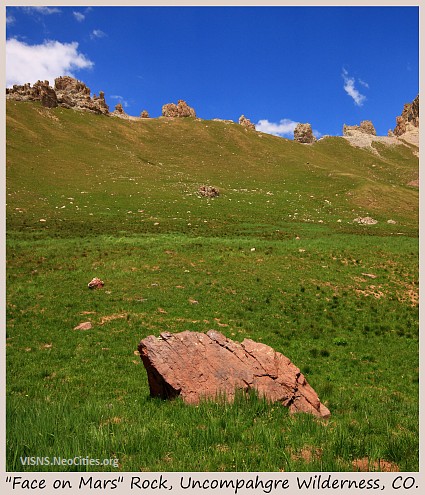
So that the curious and intrepid can see for themselves I can provide
proprietary GPS coordinates to the select few. I don't want crowds
heading into this trailless, pristine, unique place so the price is
$400.
(Four people max; scientists, artists, etc. can receive special consideration.)
There is nothing else like it anywhere in Colorado!
(No, it's not even in the otherwise excellent book Weird Colorado. Nor is it in either of Kenneth Jessen's books Eccentric Colorado or Colorado's Strangest.)
Is it natural, as it appeared to me, or is it 3-D Ute rock art? See for yourself.

Or maybe you'd be interested in some of my Large Format 4x5 Film Photography (prints only).
For framed prints (or unframed), greeting cards, coffee mugs, jigsaw puzzles, and even, yes, yoga mats, go to ColoradoWilderness.FineArtAmerica.com
Purchasing my work keeps me producing things like these Large Format Photography Beginner's Notes.

Back to Top of Page